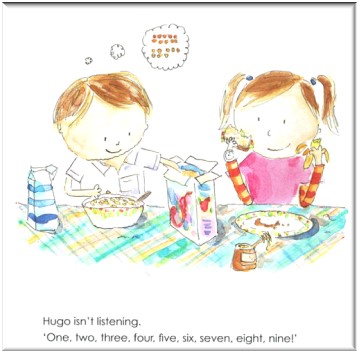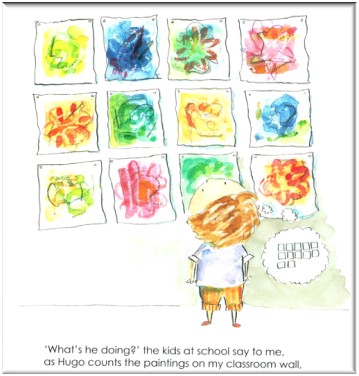Waiting for Hugo
A friend just introduced me to this lovely story book about a special little boy who loves to count. Everybody has to wait while he counts and of course his sister finds this annoying until … well I won’t spoil the plot. As a story, the book is lovely but add to that the flexible ways in which counting and quantities are introduced and the book is a real winner. Every page develops ideas about magnitude and different ways in which a number can be represented. There is even a representation of 392.
Some children arrive at school with little understanding of the why, when and where we count and some seem to have missed the absolute joy and problem solving of mastering counting. We have all met children who tell you as soon as possible that they can count to 100 as if it is a badge of honour. I feel that this book could be used to invite students who have missed such opportunities to join the ‘counting club’.
The following page sees Hugo counting breakfast cereal into his bowl.

Notice the oral count, to 9 in word form and then the organisation of 10 and 8 more in the diagram. Perhaps the class can count on or state how many times he counted in 1s after he said 9. And of course, there is a lot to be said about the diagram:
- How many in the top row?
- How many in the next row?
- How do you know?
- Do you need to count them, why not?
- How many in the bottom part of the diagram?
- How did you work it out?
- What kind of number is 10?
- What do we know about friendly numbers?
- Is there a different way the 18 pieces of cereal could be counted?
- What could it look like as a diagram and using subitizable groups.
And of course, explore ways of showing a given number of cereal pieces and you will soon see who trusts the count, how they count and organise the count and who has flexibility with representing numbers.
The page below extends this theme because here we see two diagrams of organising 12 pictures:

Clearly Hugo likes working with 10s and really seems to understand how teen numbers work.
Every page seems to sing out with a number sense opportunity, so I do recommend this book. I will be taking it into classrooms between now and Easter so may have some work samples to show soon.
If you like these ideas, you may like:
Early
Place Value
Preventing
the Numeracy Gap: Foundation Year
Preventing
the Numeracy Gap: Year 1
Cheers,

